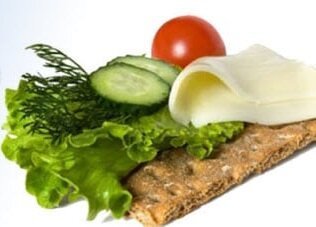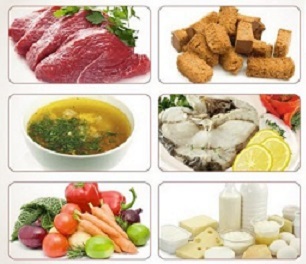The pancreas is an organ of the gastrointestinal tract, involved in the secretion of endocrine (insulin) and exocrine (enzyme). Violation of nutritional status and nutritional quality will cause irreversible damage to the function of the pancreas, which is greatly reflected in the quality of its work. Therefore, you need to know what to eat for pancreatitis to avoid inflammation of the organs.
What is pancreatitis and its dangers
Chronic pancreatitis with impaired gland enzyme function is a chronic, progressive, sluggish disease, manifested by abdominal pain, digestion and nutrient absorption disorders.
Cause of disease:
- eating disorders;
- Eat fatty foods and foods that cannot be consumed with pancreatitis;
- alcoholism;
- Eat a lot of sugar and flour products.
There are other gastrointestinal diseases-peptic ulcer, gastritis, gastroduodenitis, cholecystitis, cholelithiasis.
Constant violation of eating habits and the use of foods heavier than the stomach will cause the pancreas to violate the secretion of enzymes. In the glandular tissue, it becomes inflamed and then the duct hardens. As time goes by, the body cannot produce enough enzymes to digest food. All of this affects the quality of digestion-undigested fiber appears in the feces and produces abdominal distension in the intestines as the fermentation process weakens the absorption of essential substances and vitamins.
Signs of worsening chronic pancreatitis
Symptoms of chronic pancreatitis:
- Herpes zoster on the abdomen;
- Nausea and vomiting;
- lose weight;
- Stool disorders in the form of diarrhea or constipation.
In addition, pancreatitis may have the following symptoms-general weakness, ic, abdominal distension, dry skin, and vitamin deficiency symptoms.
Diet for acute exacerbation of pancreatitis

The main task of pancreatic pancreatitis diet is to develop a mild eating habit and choose an eating habit that can reduce the burden on the pancreas. The diet does not include products that increase gastric acidity and stimulate the secretion of enzymes in the pancreas, so every patient needs to know what to eat in chronic pancreatitis.
During the exacerbation of chronic pancreatitis, prescribe complete starvation for 2 to 3 days until symptoms are relieved. During this period, you cannot eat or even eat food. If there are symptoms of thirst, allow the patient to drink. Bed rest and complete rest can complement treatment. Cold in the abdomen.
A few days after the symptoms of exacerbation of chronic pancreatitis disappear, you should follow a specially formulated diet. In medicine, this is Table 5.
The food should be slightly warm. Avoid foods that are too hot and too cold.
Product cancellation
What should not be consumed in the diet of pancreatic pancreatitis:
- It is absolutely forbidden to eat high-fat meat-pork and chicken skin;
- Strong broths (fish and meat) are excluded from the diet because they have a fermenting effect and can cause stomach pain.
- Beans and cabbage are not allowed-they are not only rich in crude fiber, but also cause more gas to form.
- Any carbonated beverage;
- Smoked, fried or grilled food;
- Coffee, strong tea, chocolate and cocoa products should be kept to a minimum;
- Turn off any alcohol and fresh bread;
- The ice cream for pancreatitis should be restricted;
- Does not include any seasonings-onion, garlic, pepper;
- Hard boiled eggs;
- Any form of mushroom;
- Fatty types of fish are not included, saury, mackerel, eel, el fish, Ivasi fish, Caspian herring, silver fish, Notothenia, st fish.
Any candies, pies and sweet tea should not be consumed in pancreatitis, because the high sugar content in the intestines can cause fermentation and bloating.
In addition, as pancreatitis worsens, additional medications need to be prescribed, which may include the following types of drugs: proton pump inhibitors (to reduce gastric juice secretion), enzyme drugs, adsorbents, antispasmodics, and pain relievers.
Pancreatic pancreatitis aggravated menu
Diet development
The menu includes the following foods. The use of these foods provides the human body with necessary nutrients, but at the same time has no stimulating effect on the pancreas. Food is steamed or cooked and should not contain unprocessed vegetables or fruits.

The soup should be placed in water or low-fat meat (fish) soup. It is best to rub all the mucus or rub. Under no circumstances should it be fried in soup. Congee must be boiled in water or half diluted with water and cooked.
The menu should include meat and fish. But not the fat variety. The fish that eats the most is cod, which has a fat content of 1. 4%. Such fish are quickly digested by the gastrointestinal tract and easily digested. It does not strongly stimulate the enzymatic function of the pancreas, so it is considered optimal for pancreatitis.
For meat, preference is given to rabbit, turkey, beef tenderloin or chicken breast. Steamed meat products, roasted or cooked with vegetables. You can cook meatballs or half a vegetable steak.
The menu includes the following foods:
- Steamed, boiled or stewed vegetables;
- "Yesterday's" bread;
- Roasted fruit (apple);
- Low-fat lactic acid food;
- Drinks-jelly, jelly, light tea;
- Lean meat-chicken breast, turkey, beef and veal tenderloin, rabbit;
- Low-fat sea fish-pollock, blue whiting, cod, flounder, roach, cod;
- Lean river fish-bream, perch, spear, lance perch, fish, perch.
The last meal should be no later than 2-3 hours before bedtime. For snacks before going to bed, biscuits and candied fruit or jelly are preferred.
Menu design
A sample menu for one day of chronic pancreatitis. Turn off products that cannot be consumed with pancreatic diseases, and choose a diet that is as gentle as possible for the body.
- Breakfast:Steamed omelet, boil the porridge in milk (buckwheat, rice or other), and boil half of it with water and dilute tea. Options: oil-free semolina porridge, dried fruit preserves and biscuits;
- The second breakfast (lunch):Low-fat cheese, about 100 grams, jelly or preserves. Options: baked apple or cheese casserole;
- Lunch:Vegetarian soup, boiled chicken breasts and dried fruit preserves. Options: no fried soup, steamed meatloaf, rose hip soup;
- Snacks:Baked apples or biscuits with rosehip soup. Option: a cup of low-fat kefir;
- Dinner:Vegetable puree (potato, zucchini, carrot), pork chop, herbal tea. Options: milk porridge, boiled chicken breast, jelly;
- Evening snack:A glass of low-fat kefir or fermented baked milk or jelly. Choice: rosehip soup.
When asked if ice cream can be used for pancreatitis-the answer can be given-they limit the use of fat and very sweet ice cream. Only ice cream can be added to the diet, no more than ½ pack, and nothing (chocolate, nuts, condensed milk) can be added.
Patient Memo

Every patient should understand the dietary rules and pancreatitis should not eat.
Consider suggestions:
- Meals should be snacks, ie small portions up to 5-6 times a day;
- They adhere to the diet for at least half a year, although in the end, the patient must adhere to this diet for life.
- Food should be high in calories as needed;
- Do not eat the foods listed above to prevent pancreatic disease;
- Overeating is not allowed;
- Is pancreatitis ice cream possible-restrict the use of low-fat ice cream.
In addition, any disease of the gastrointestinal tract must be treated in time to prevent complications and reduce the number of exacerbations.




























